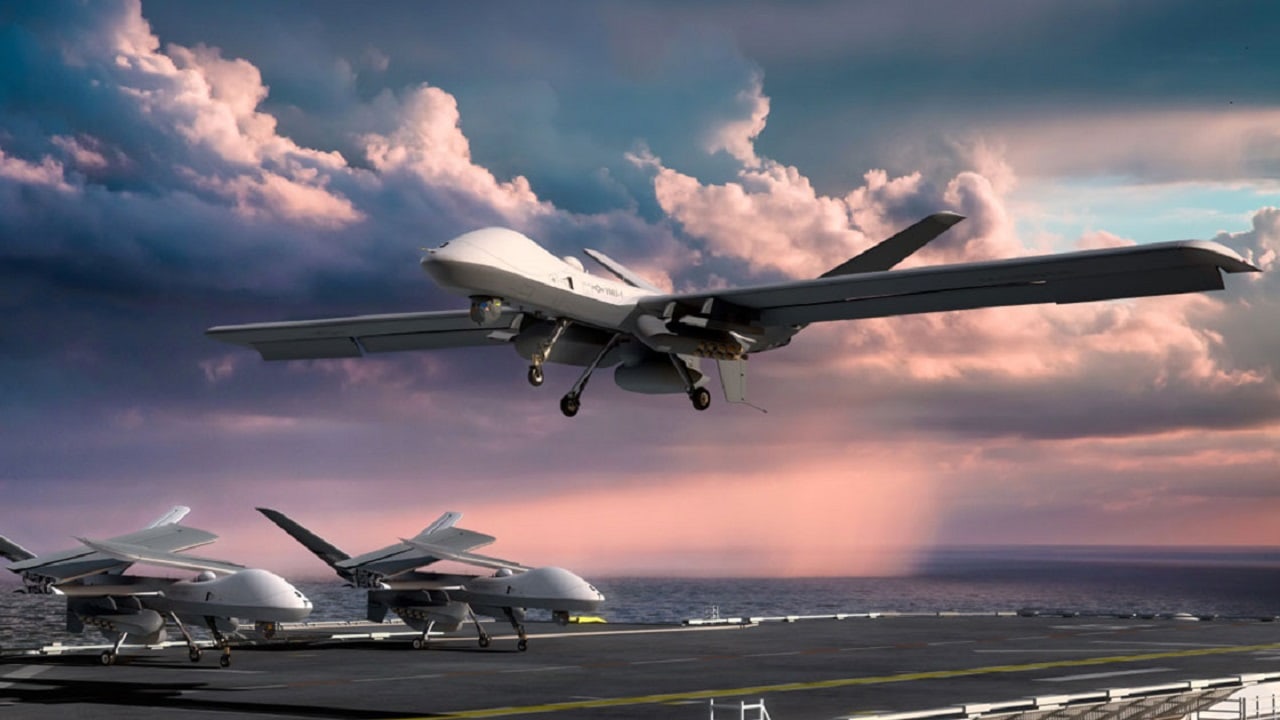The U.S. Navy and Marine Corps could soon be getting a new remotely piloted aircraft with prized capabilities.
Recently, General Atomics revealed a short take-off and landing (STOL) version of the highly effective MQ-9B SeaGuardian unmanned aerial system. As competition with China in the Indo-Pacific continues, the new drone module could be very useful.
The MQ-9B STOL
Essentially, the MQ-9B STOL is a short take-off and landing version of the MQ-9B SeaGuardian, the maritime version of the venerable MQ-9 Reaper.
The MQ-9B SeaGuardian has a wingspan of 79 feet and a length of 38 feet. It is powered by a Honeywell TPE331-10 Turboprop engine that can power it to a maximum speed of 210 knots per hour (241 miles per hour). It can carry up to 6,000 pounds of fuel and can pack 4,800 pounds of munitions in nine hardpoints (four in each wing and one underneath the fuselage).
The unmanned tactical aerial system comes with many pros compared to manned aircraft. To begin with, the MQ-9B STOL costs approximately $5,000 an hour to operate and uses about 200 pounds of fuel an hour and has a loiter time of around 25 hours.
In comparison, a manned maritime patrol aircraft, such as the P-8 Poseidon, costs about $35,000 an hour to operate and burns approximately 5,000 pounds of fuel an hour and can stay on station for about 10 hours.
In short, according to General Atomics, the MQ-9B costs 86 percent less to operate per hour, burns 90 percent less fuel than similarly configured manned Intelligence, Surveillance, and Reconnaissance aircraft, and half the amount of people to support and operate.
When it comes to armament, the MQ-9B STOL can carry the standard AGM-114 Hellfire air-to-ground missile but also might have the ability for some more exotic options. According to the promotion videos that General Atomics released, the unmanned aerial system could sport the famous AIM-9 Sidewinder infrared-guided air-to-air missile, thus giving the MQ-9B STOL some potent air-to-air capabilities.
The MQ-9B STOL Brings Flexibility
The MQ-9B STOL is designed to operate in expeditionary operational environments in which normal landing strips will be either hard to come by or contested.
The U.S. Air Force, Navy, and Marine Corps have spent increasingly more time and resources refining their expeditionary and dispersed warfare capabilities in response to the upgrade of the Chinese military. The idea is to have smaller units dispersed throughout the operational theater in order to make it harder for Chinese long-range fires to take out or tie-down whole units. For example, a squadron of F-35A aircraft could be restricted if a barrage of Chinese ballistic missiles took out the landing strips.
It should be noted, however, that the MQ-9B STOL doesn’t have vertical landing capabilities. In other words, it is not a short take-off and vertical landing (STOVL) aircraft, like the AV-8 Harrier or the F-35B Lightning II stealth fighter jet. That, of course, doesn’t mean that the MQ-9B STOL brings to the table lots of benefits.
STOL and STOVL aircraft offer commanders great flexibility as they can operate easily from almost anywhere, including impromptu landing strips and even highways.
“STOL means we can take this incredibly capable, long-endurance aircraft and get into and out of more airfields in more places. If you need to have these aircraft switch up where they’re operating – either because you don’t have a long, conventional airfield, or because you don’t want an adversary to know where one might land after a mission – you have numerous options about where you can operate,” Dave Alexander, an aerospace engineer and the president of General Atomics Aeronautical Systems, Inc, said in a Q&A about the MQ-9B STOL.
As far as potential uses go, General Atomics claims that the MQ-9B STOL can offer a lot, including Intelligence, Surveillance, and Reconnaissance (ISR) and precision strike capabilities. If one asks ground troops what their most favorite platform for close air support is, remotely piloted aircraft always come on the top-3 as they provide excellent loiter time on station and can deploy munitions if necessary.
“For one thing it incorporates high-quality, persistent intelligence, surveillance and reconnaissance into the Marine Air-Ground Task Force that just doesn’t exist today. With future shipboard operations, it has the endurance to operate around the clock when the ship is not at flight quarters,” Alexander said.
Having an unblinking eye in the sky offers a lot of benefits as it can increase the survivability of the mothership by spotting and tracking threats early.
“Imagine the ship does flight ops for several hours and then secures from them for the day or night, without plans to fly anything on or off again for awhile. MQ-9B STOL doesn’t need to come back with the rest of the aircraft, if you want to operate it that way. It stays up and continues working,” Alexander added.
1945’s New Defense and National Security Columnist, Stavros Atlamazoglou is a seasoned defense journalist specializing in special operations, a Hellenic Army veteran (national service with the 575th Marine Battalion and Army HQ), and a Johns Hopkins University graduate. His work has been featured in Business Insider, Sandboxx, and SOFREP.

